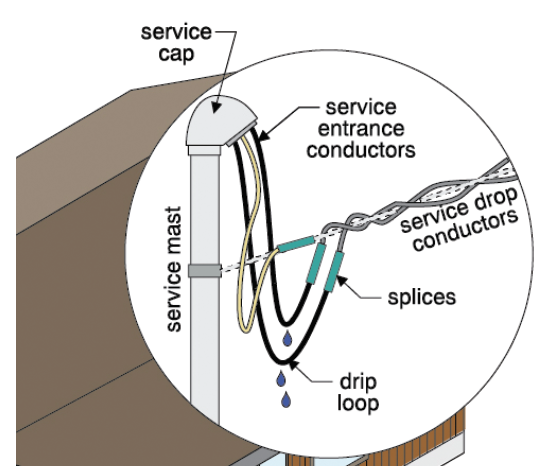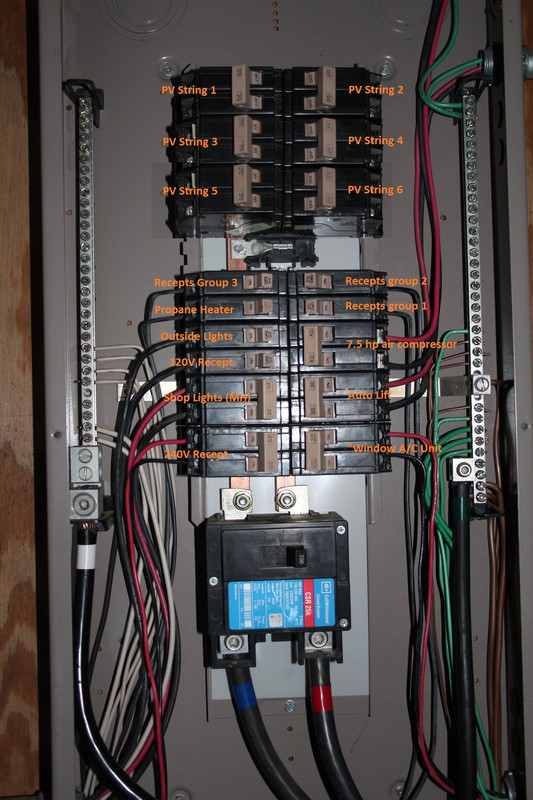Ang explanation po kasi nila sa mica tubing is if ever sumabog daw hindi daw basta basta masisira or makakalusot sa mica tubing unlike plastic PVC utility box na pwede yata matunaw? But I'm not sure how that checks out kasi there's wire coming out of the receptacle na hindi covered ng mica tube. I just agreed since I was trusting their word being licensed electricians and the person I went to vouched for them. It seems like I should have exercised more caution.
Maybe may point siya but hindi acceptable conduit material for AC wiring ang mica tube. Eto ang ginagamit na conduits for electrical wiring:
:strip_icc():format(webp)/seven-types-of-electrical-conduits-84e1346c166b40fd9db302fcc8856a08.png)
<click here for link>
Moreover, kung protection ang habol niya hindi acceptable na may exposed wiring. Ang wires fully enclosed dapat ng conduit, then ang conduit nagteterminate sa outlet box. So yung ginawang trabaho medyo pointless, protected nga ng mica tubing most ng wires pero meron exposed. Eh paano kung doon nginatngat ng daga at ma-expose ang wire? Yan ang perfect example ng mga Filipino-style "pwede na" attitude na walang pakialam sa standards! BTW, kung yung may issue siya sa durability ng PVC against "pagsabog" then just use metallic conduits, yan rin may highest resistance to damage against stuff like rodents.
Tinanong ko po kasi ito sa electrician na nagkabit ng outlet. Akala ko po kasi kailangan ingatan ang outlet dahil pwede mag overload tulad ng sabi niyo, at ito din po ang rason kung bakit nagpagawa ako ng bagong outlet kasi sa kwarto ko isa lang ang outlet at madami nakakabit. Minsan pa nga napapagamit ako ng daisy chaining which is supposedly bad (pero sabi din ng electrician hindi daw basta makapal yung wiring ng extension cord, but I wasn't sold on that thought).
Technically, ang issue is hindi sa number of connected devices sa single outlet pero yung total load (wattage or more precisely, volt-amps for AC). Eh kung puro cellphone charger ang naka-plug sa single outlet using multiple extension cords kahit 20 pa yan pwede.
Ang pagkakaintindi ko po kasi ang maximum load na kaya ng isang outlet ay dipende sa circuit na nakakabit siya. Sa isang circuit po daw around 2200 watts maximum ang kaya bago mag trip. Then ang bawat outlet po daw ang sabi niya ng una 100w max load daw puwede, pero sabi ko "ah oo nga po, nagpagawa din ako ng bagong outlet kasi sumosobra ng 100w ang gamit ko sa outlet na luma" then sabay sabi niya ok lang daw yun kahit sumobra. I gave an example of 300w load at sabi nila pwede. At that point parang feeling ko po wala mapupuntahan usapan kaya nag agree nalang ako. Parang di din po kasi sila open to much questions. Trabaho lang.
Ang maximum load ng isang outlet ay dependent sa ratings ng lahat ng involved sa circuit, specifically yung receptacle rating, yung gauge ng wire and yung circuit breaker/fuse rating. Yung 100W per outlet nonsense yan, dito pa lang sa TipidPC makikita mo may nag-wattmeter ng gaming rigs nila under full load, meron umaabot ng 500 watts pataas. Morever, tignan mo ang ratings ng iba't ibang appliances like microwave, flat iron, etc. na nakasaksak sa outlet, lagpas lagpas yan ng 100 watts.
Ang 2200 watts na binanggit is computation for six 2-receptacle convenience outlets (CO). Ang sabi kasi ng PEC ang minimum load to be assumed for each receptacle is 180 volt-amperes; 12 x 180 watts per outlet = 2,160 watts which is near 2.2 kW. Ang minimum size ng wire for COs is #12 AWG or 3.5 mm^2, which is rated for 30-35 amps for most kinds of wires (e.g. TW, THHW, THWN, etc.) used in residential applications. 220 volts x 30 amperes is 6,600 VA. Ang appliance circuits maximum allowed amperes is 20 amps, which will be protected by a fuse or circuit breaker designed to carry 80% of the max load = 16 amperes, 16 x 220 V = 3,520 VA. So hindi totoo na magtri-trip ang circuit breaker or mag-melt ang fuse at > 2.2 kW since ang 20 A circuit breaker carrying the maximum allowed load is carrying 3,520 watts. Ang tripping threshold is actually set much higher than this; for example yung 20 amp breaker allowed to carry up to 40 amps as long as it trips in < 120 seconds.
In short, in your typical 20 amp residential circuit feeding appliances, protected by a 20-amp fuse or circuit breaker, 2.2 kVA is conservative estimate and in reality pwede yan mag-carry ng up to 3.5 kVA (80% of the breaker rating). Your #12 AWG wire can actually carry a load of up to 6.6 kVA so may considerable safety leeway. How about each individual receptacle (wall socket)? Most are rated at 10 A at 250V = 2.5 kVA, so supposedly even a single socket can carry the entire 2.2 kVA conservative estimate. In short, mahirap mag-overload ng isang wall socket unless magplug ka ng several high-wattage appliances at sabay-sabay silang naka-on. In the entire chain, the wall socket actually has the lowest rating (socket 2.5 kVA, AC wiring 6.6 kVA, fuse/breaker 3.5 kVA) so baka yan unang masunog/matunaw; of course kung meron kang extension cord na manipis with a lower rating pwedeng yan ang unang masunog.
How do I know if my room or house has any AFCI installed? My family's home that I currently live in was built in 2009
Nearly zero ang chance, because despite being in the PEC as a requirement parang walang local stores na nagbebenta ng AFCIs based on Google searches. Mabuti pa ang GFCI or GFCI circuit breaker/RCBO, mas madaling hanapin at locally available, especially yung GFCI receptacles. Kung nagpapagawa ka ng bahay at nagpa-plan ka ng best electrical protection, mukang kailangan bilin abroad ang AFCI (meron sa suking online stores, though puro Chinese brands like Taixi ang listed). In any case, kung gusto mong malaman talaga just look at the main service panel or subpanels and look for an AFCI:
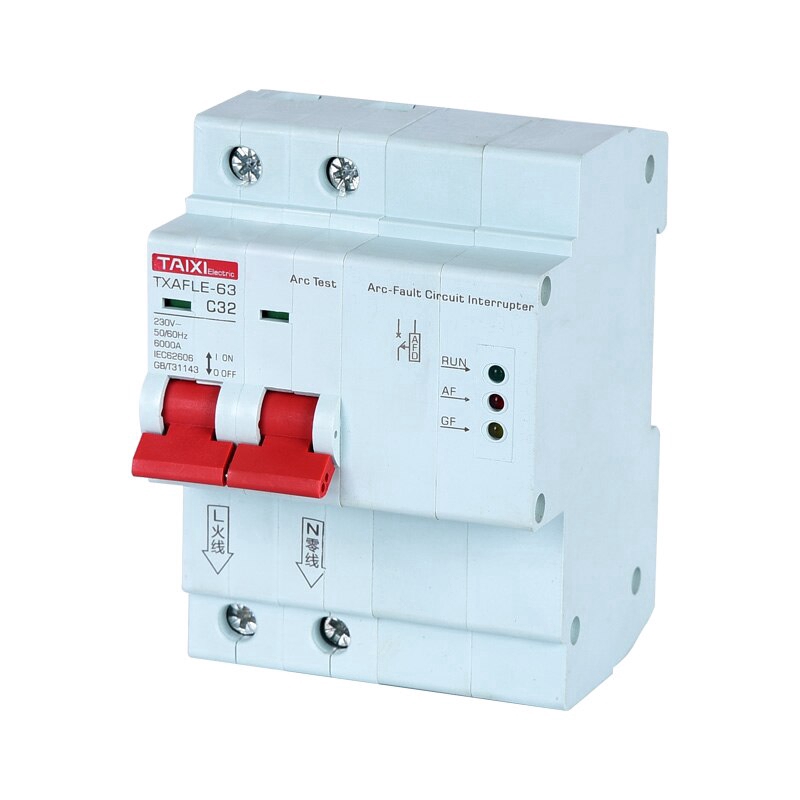
(Note na since 220 V ang standard voltage sa Pinas these safety devices are double-pole, i.e. twice the usual width of single-pole devices, so that both "hot" lines are broken when tripped. Sa 110-volt systems isa lang ang hot wire so that you only need to trip one line with a single-pole breaker)
All three electricians I talked to this past month didn't know about GFCI (or EL Guard) outlets because I was hoping to have one installed in my kitchen and bathroom where a water heater resides.
Only goes to show that ang daming "pseudo-electricians" sa Pinas. Ang GFCI and AFCI parehong nasa PEC, though konti lang ang entries ng AFCI compared as GFCI. Kung tunay na electrician sila, dapat may idea sila at least sa GFCI because sobrang daming entries ng GFCI with regards kung saan sila ginagamit, e.g. tabi ng pools, fountains, sa bathrooms, etc.
At this point I didn't get answer from any electricians about the kind of Meralco line we have. I was told that we don't have a three-phase so it's probably single phase, but then I don't know if this means we have a hot/neutral wiring where the neutral is earthed. Nakita ko kasi sa labas ng poste namin meron grounding rod ng Meralco. And may white wire sa meter namin which I was told is ground... Pero ang sabi sa akin tumawag daw ako sa Meralco kasi 'disconnected' daw ang ground namin and pointed to a bunch of wiring atop of the poste. Sa kabit bahay daw namin di naman daw disconnected. So don't know if the neutral is earthed, and if it is, then it probably doesn't work if it's 'disconnected' or putol.
Lahat ng residential single-phase ang supply, ang three-phase is used sa industrial and large commercial applications dahil mas efficient ang large equipment, particularly motors, using a three-phase supply.
Di mo naman kailangan tumawag sa Meralco, labas ka lang tapos tignan mo service drop niyo (yung wires papasok sa bahay mula sa poste or yung wires between electric posts. Ang typical Meralco installation is yung so-called "line to line". Ang papasok sa bahay ay THREE conductors, two na live or "hot" (think of each as 110 volts) plus one neutral. Ang neutral is supplied through an uninsulated (bare) aluminum conductor which also serves as yung support ng two live wires (dun nakapulupot ang wires). Ang dulo ng aluminum cable is bonded to a copper conductor, na pumapasok sa service cap/weatherhead along with the live wires, then pumapasok na sa bahay, typically passing through the electric meter:
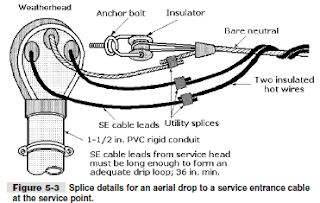
Ang grounding rod sa poste ng Meralco is grounding for the neutral, typically every post may grounding rod to ground the neutral. Ang ground ng bahay is different mula sa ground ng Meralco because hindi nagsu-supply ng ground ang Meralco unlike in other countries. Sa Pinas ang grounding system natin ay terre terre (TT), meaning ang protective earthing is provided by a local earth electrode. In other words, ang bahay dapat may sariling grounding system using grounding rod(s) or something else like concrete-encased electrodes (Ufer system). Kung may grounding ang sockets niyo sa bahay (maraming bahay sa Pinas walang grounding!), ang grounding wire from the conduits will go to the service panel, and from the service panel may grounding wire papuntang grounding rod(s) or equivalent.
Note na meron some references na nagsasabi na may Meralco installations ng a two hots lang at walang neutral, so important to check kung ano ang pumapasok sa bahay. Also, sa province uso ang "line to neutral", meaning two wires lang ang papasok sa bahay: 1 x 220 volt "hot" or live line, plus one neutral. Walang way gumawa ng 110 volts with this system except using a step-down transformer.
This is an interesting (or frightening) case because currently my outlet's ground is screwed to my metal panel board. I'm freaking out kasi ang pagkakaalam ko pwede mag overheat or worse electricute dahil ang discharge ay doon mapupunta. I don't know if the screw they screwed it on is bonded, or if the panel board is earthed/grounded. I was just assured that this ground will protect my devices in case of a surge. Though they offered me to 'extend' the current ground wire and attach it to the grounding rod of Meralco sa poste outside. I'm not sure if that's safe or allowed by Meralco...
Let's say meron kang 10 sockets with a grounding wire. Ang grounding wires na yan should end up in your main service panel. Ideally may sariling busbar (the metal bar with holes and screws to clamp wires together) para malinis, then yung grounding wire from the grounding system (e.g. grounding rod) is screwed to that busbar. Yung metal service panel is also connected to the ground (e.g. wire from a busbar terminal to a screw in the panel) for safety purposes. Then yung neutral may sariling busbar, which is always bonded to the ground at only ONE POINT in the entire home at the main service panel, bawal na bonded ang neutral ang ground elsewhere like subpanels. BTW, kung wala kang 110 volt outlet you don't need a neutral conductor going to the outlet. To make it clearer:
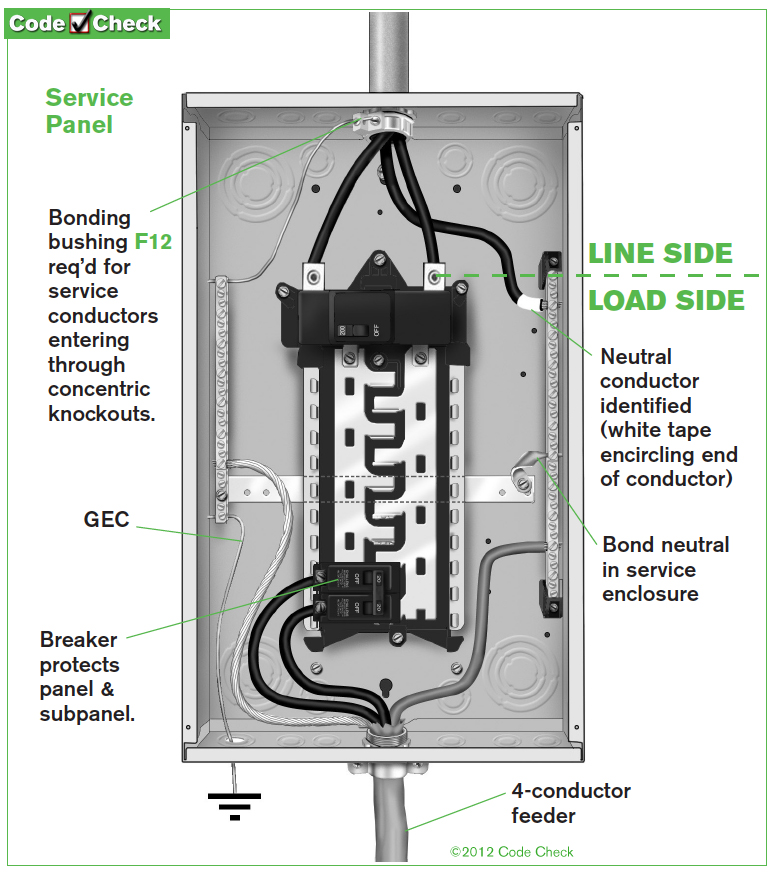
Note here important points:
1. Supply from the power company (LINE side) 3 lang, 2 hots and one neutral. Ground is supplied locally, then pag exit sa LOAD side (going to outlets) 4 ang wires: two hots, one ground, one neutral. But again, if wala talagang plan gawing 110 V ang socket, even in the future, pwede hindi na maglatag ng neutral.
2. The neutral (right) and ground (left) busbars are bonded together by a horizontal metal connector.
3. Not shown clearly, but the panel should also be grounded by means of a connection to the grounding wire or ground busbar.
At first I asked them if they were going to ground my outlet by using a grounding rod, but wasn't sure what materials are required like is it going to be a rebar or one of those grounding rods they sell on Shopee. I was going to rely on what they know kasi to begin with I don't know where the grounding rod should be impaled. For example the area near my panel board sometimes gets wet, so not sure if that will introduce a hazard.
Pero ang sabi nila di na daw kailangan?? So they screwed my ground wire to the panel board. I am so confused. Not to mention I am even more confused because I've read somewhere na just because there's no third wire it doesn't mean the outlet isn't grounded (as long as the CORRECT implementation has been made, which is a coin flip unless you have a really good electrician) which is presumably from the prior knowledge that some neutral line here in the PH is earthed...
Dapat kasi alam mo kung meron ground yung electrical system ng bahay niyo to begin with. Hiwalay to na wire na papasok sa panel, as shown above. Again, 3 from Meralco (hot x 2, 1 x neutral) assuming line-to-line ang supply niyo, then 1 grounding wire, which can be traced back to the grounding system. Pwede i-screw yung ground wire ng socket sa metal panel as long as yung panel is grounded to begin with, meaning ang grounding wire is screwed to the panel itself. Kung walang grounding wire going to the panel then useless ang ground wire na linatag papuntantg socket.
Though they offered me to 'extend' the current ground wire and attach it to the grounding rod of Meralco sa poste outside. I'm not sure if that's safe or allowed by Meralco...
I don't think acceptable yan kasi tampering yan with equipment ng electric company. Ang best gawin, kung walang ground ang bahay (common sa Pinas!) ay maglagay ng sariling grounding system. Most commonly grounding rod(s), pero may other ways like using metallic water pipe pero lahat yan may requirements. Kung grounding rod system ang plano, mo eto ang requirements, as stated in the PEC:
Rod and Pipe Electrodes. Rod and pipe electrodes shall not be less than 2 400 mm in length and shall consist of the following
materials.
a. Electrodes of pipe or conduit shall not be smaller than metric designator 21 (trade size ¾) and, where of iron or steel, shall have the outer surface galvanized or otherwise metal-coated for corrosion protection.
b. Electrodes of rods of iron or steel shall be at least 16 mm in diameter. Stainless steel rods less than 16 mm in diameter, nonferrous rods, or their equivalent shall be listed and shall not be less than 13 mm in diameter.
So kung iron or steel pipe (a), dapat 21 mm or 3/4 inches ang size, kung solid steel or iron rod at least 16 mm (1.6 cm) ang diameter; minimum length for both is 2.4 meters. Best place ibaon would be soil na may moisture para mas conductive ang earth. May cases kasi na hindi conductive ang earth (mataas ang resistance in ohms), so more than one grounding rod ang kailangan. Or you can make the rod longer so that umabot siya a wet earth near the water table.
I was already losing hope with all the different electricians I have hired so far. Every time I mention them if they are familiar with whole house surge protection (along with other electrical safety practices that are apparently not popular here) they tell them hindi uso, even for grounding outlets. Sabi nila sa akin mostly prop lang ang third prong, at hindi din uso ground dito. So I never bothered asking them to make me a grounded outlet since I figure if I insist they might cave but do a halfed-ass job just to satisfy me and pray that I don't know whether or not they've done a proper job. Meanwhile, this other electrician that worked on my grounded outlet, maybe I should have known when they kept asking what the grounded outlet was going to be for... I was going to say "safety" to them originally, but I was dreading the standard reply where the question is at risk of sounding like a joke to their ears. So I just told them my surge protector's warranty requires a ground (which it does). And that's probably why I ended up with the grounded wire screwed to my panel board (or circuit breaker box) assuring me it will do a fine job against surge. I don't have high hopes for it because of the other decisions they've made, but admittedly I'd still be gutted if it turns out to be a flop. The job would have been a pointless expense then even after several electricians.
Meron whole-house surge protectors rin, pero di uso. If you want the whole works of electrical safety features, malabo na makahanap ka ng marunong na electrician except siguro if you're dealing with a licensed electrician na familiar sa industrial and commercial projects kung saan mas stringent ang requirements. For example, lahat ng high-end hotels na napuntahan ko ang bathroom outlets ay GFCI receptacles, in compliance with the PEC.
For a fully electrically hardened/protected house, best would be kapag nagtatayo ka pa lang ng bahay kasi mahirap mag retrofit. From the get go dapat planned out ang electrical supply ng bahay with with the full suite of protection devices installed sa main panel and subpanels, if necessary. This would include:
1) circuit breakers - for overcurrent
2) whole house surge suppressor - for surges
3) GFCI breaker / residual-current circuit breaker with overcurrent protection (RCBO) - better to use this instead of a pure GFCI/RCD/RCCB para may overcurrent protection rin and will cut down in the number of circuit breakers needed - for ground fault, i.e. electrocution hazard
4) arc fault circuit interrupter (AFCI) - to mitigate fire hazard caused by arcing/sparks
If you're curious how a RCBO/GFCI breaker is mounted and can protect subsidiary miniature circuit breakers (MCBs) pwede mo tignan tong video na to:
For houses na high lightning hazard (e.g. solo house on top of a hill), pwede rin maglagay ng lightning protection system, may companies locally na specialized sa installation nito though typically for commercial/industrial applications.
Going back to grounding, ikaw na lang gumawa at malamang mas matino pa trabahong gagawin mo. Bili ka ng 3/4" (21 mm) galvanized iron or steel pipe, minimum length of 2.4 meters pero pwede mo pasobrahin, e.g. 3 meters. At one end, drill a hole and put a bolt and screw to secure yung ground wire. Alternatively, buy a commercial grounding rod which conforms to yung PEC specs. Wire the ground wire to the grounding rod, then ilatag papuntang service panel, screw to metal case of service panel and using the same screw pwede na i-connect yung ground papuntan sockets. Kung maraming ground wires, better to install a separate busbar. For the neutral, don't forget na dapat bonded rin siya sa ground sa service panel.
Also, kung mahirap maglatag ng new wires sa existing sockets/conduits, pwede naman hindi padaanin dun. For example, yung bahay namin walang grounding ever since tinayo. Nung nag-install kami ng water heater sa bathroom, nag-wire kami ng ground papuntang grounding rod. Since yung bathroom eh nasa extreme edge ng wall (i.e. yung bakuran na ang nasa labas), yung ground wire galing socket pinadaan lang namin through yung bintana and secured sa outside concrete wall using cable clips, then nakadikit sa grounding rod.
-- edited by Peorth on Dec 27 2020, 02:30 AM


